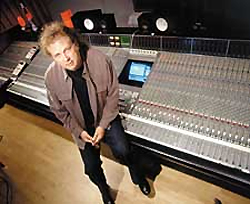
How in the universe did you get the kick drum on Rick Ross ‘Deeper Than Rap’ so prominent, and maintain it through the mastering process? What do you do to prepare for the brickwall?
Philosophical answer – I don’t think in terms of volumes. There’s different elements available to us as mixers: power comes from low end, the speaker that creates low end is ten times the surface, the amp that controls low end is huge, the tweeter is 60 watts. What that tells you is that all that energy gives you the impression of power.
In rock music, credibility is guitars. Rock engineers will add low end to the guitar for power – Andy Wallace does it with drums – Chris Lord-Alge does it with guitars.
In Chris’s case, he’s a genius at making the vocal sit on top, but not compete. He crafts a spot where the vocals can convey their energy. It’s something I study all the time. CLA and I have been on the same album, I’ve learned a lot. Sometimes if I’m doing R&B, I’ll use the vocal as a fill with a rhythmic delay at bars 8 or 16 – it’s the ‘here comes the chorus’ cue.
I’m not actually thinking about the kick drum, I’m thinking about power and credibility. We might have more high end in a pop mix, because the high end gives the feeling of expensiveness. What’s most important though is the concept.
Going back to the idea of ambience, Allen Mireson used nonlinear delays on vocals to lay the vocalist in the pocket. Reverb plays a very important timing role. Silence, the holes where there’s no music – can be as precious as the moments where there is music – if you fill all of the silence with reverb, it becomes monotonous.
I’ll take a reverb and put a gate after it, and I’ll side chain the reverb to the vocal – so the reverb turns off when the vocalist stops singing. I’ve been known to draw it out even [automate the reverb return level]. Another thing, on a verse if you’re not quite getting that excitement, rather than rolling the low end off of the reverb, use a harmonizer before the reverb, and kick it up an octave.
Chris Athens turned me on to a technique of tucking pitch shifted clones of the lead track in at the end of lines to re-emphasize the harmonic moments.
Sure, nothing is sacred if you’re working on feel.
Double mic techniques? Vocals?
I might use more than one mic if I have to capture a singer and I’ve only got one take. I have two mics to maybe have some options later.
How about splitting a guitar to different amps?
On a guitar, I might split the signal to an amp that gives different information. Some amps have a good treble sound, making the upper strings for lead parts sound good – others have a good bass sound for rhythm parts. It’s just getting different parts of the sound, and the creativity is picking and choosing how to use it.
Do you think this kind of stuff can be overkill sometimes?
I get tracks where the producer couldn’t make up his mind. 250 tracks, I could mix that, but it takes forever. I’m a believer in commitment – the trade off of not having something you want to change later is not as important as capturing the moment as is. Sometimes you miss out, but the commitment is more. Mixing is a couple of thousand commitments – I don’t do five mixes, I do the one I want to hear.
Tracking is an environment where you are capturing a moment in time, that moment contains sonic information – it contains everything like a snapshot. Sometimes you get a snapshot where your eyes are closed, sometimes you get one peeing behind a bush – but when you see the whole album you get the feel for that moment in time.
Most mixes I have one day to do. I could spend a day repairing or I can spend time mixing. If I do three hours of repair and 15 hours of mixing, that will be better than three hours of mixing and fifteen hours of repair. Tracking isn’t about perfect or imperfect – its about giving the mixer the best material for the end results.
